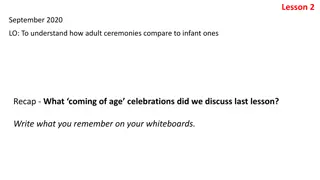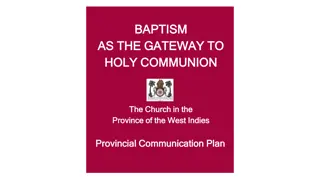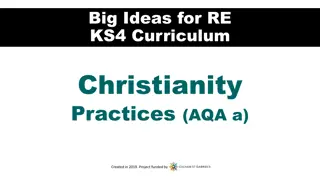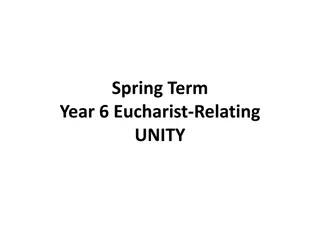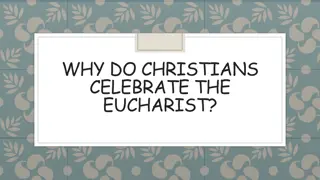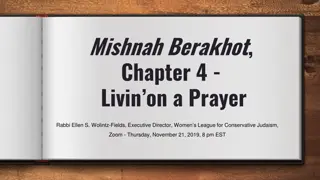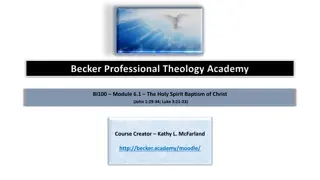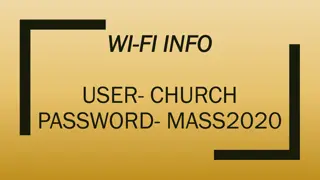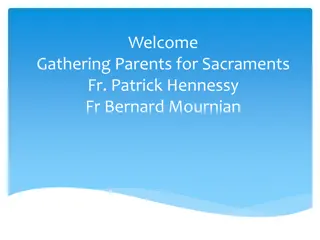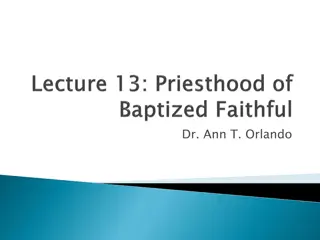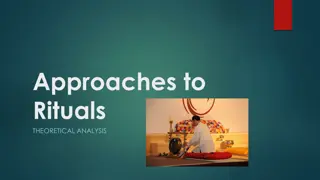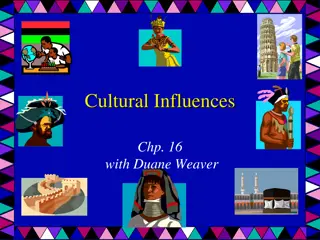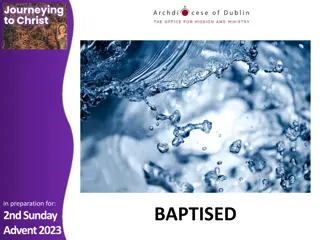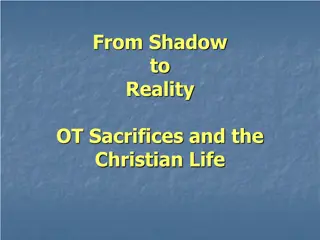Exploring Ancient Christian Rituals: Baptism and Eucharist Diversity
Delve into the significance and diverse interpretations of Christian practices such as baptism and the Eucharist, exploring historical contexts, modern observances, and Reformation-era conflicts. Understand the variations in beliefs regarding infant and believers' baptism, different ways of celebrating the Eucharist, and the enduring relevance of ancient rituals in contemporary religious practices.
Download Presentation

Please find below an Image/Link to download the presentation.
The content on the website is provided AS IS for your information and personal use only. It may not be sold, licensed, or shared on other websites without obtaining consent from the author. Download presentation by click this link. If you encounter any issues during the download, it is possible that the publisher has removed the file from their server.
E N D
Presentation Transcript
Big Ideas for RE KS4 Curriculum Christianity Practices (AQA a) Created in 2019. Project funded by
3 3- -4: today? today? 4:Why follow ancient rituals Why follow ancient rituals BIG IDEAS LEARNING BELIEFS: recap nature of Christian God, link to purpose of sacrament CONTEXT: baptism- history of Christian baptism, different views Eucharist- Reformation-era conflict about Eucharist DIVERSITY: different Christian views on baptism and Eucharist From the spec Baptism: significance for Christians; infant and believers baptism; different beliefs about infant baptism Eucharist: significance for Christians, including different ways in which it is celebrated and different interpretations of its meaning. Learning outcomes: Define sacrament, eucharist and baptism Explain why modern Christians observe these sacraments Explain diverse views of both eucharist and baptism the meaning of sacrament Resources 3 Baptism 4 Eucharist squares
Lesson 3 Starter: show videos of Christians engaged in rituals: with the sound turned down. If the class were explorers from another part of the world and had never seen these rituals, what would they think was happening? Brainstorm why people perform religious or non-religious rituals. (ritual: repetitive, formalized, meaningful actions, linked to a belief or myth). In Christianity these are known as sacraments . Define sacrament. Read John 6 on 3 Baptism worksheet, answer questions around the edge. Ask students to suggest what the idea of birth in water signifies in this passage. Do students think baptism was something Jesus developed? Teach that in fact it was a widespread practice to symbolise commitment, spiritual cleansing and spiritual rebirth. Read Matt 3 on 3 Baptism . Answer the questions. Ask students which event came first. Jesus baptism is first. Ensure students can identify who baptises Jesus John the Baptist. Explain that John the Baptist led a Jewish messianic movement. He was already teaching that a messiah will come, and baptism represented his followers cleaning themselves in preparation. After his own baptism Jesus recommends such a procedure to Nicodemus in John, implying that through being symbolically reborn humans can prepare themselves for God Ask the class why, if Jesus was baptised as an adult, Christians baptise babies? Do the class think infant baptism is in the Bible? [It is not in the Bible]. Explain that the Baptist church refused to engage in infant baptisms during the Reformation. Why do students think this is the case? [Biblical baptisms are adults making a commitment]. EXTENSION: read the quotes (on slide) referring to a conflict around baptism in the Reformation period Find images or videos of Baptist full immersion in Baptisteries. Ask why Baptists do not engage in infant baptism. Find images or videos of infant baptism. Ask why families baptise their babies. Create a list of reasons why infant and adult baptism are practiced. Return to initial question: Why do people follow ancient rituals today? Answer using baptism as an example
Baptism Conflict Baptism Conflict During the Reformation period, arguments surrounding baptism raged. Some, such as the Anabaptists, argued that Christendom had been in error since at least the second century (Alec Ryrie, 2017, Protestants: The Faith that made the Modern World, p. 38). Other reformers, including Luther and Calvin, felt that infant baptism was essential, even if not in the Bible. Without it, the church would simply fall apart (Peter Marshall, 2009, The Reformation: a Very Short Introduction, p. 52).
Lesson 4 Starter: show Da Vinci s painting of the Last supper. Show a Eucharist chalice and plate (or an image of one). Ask the class to connect the two. Using the information 4 eucharist squares , create a 10 minute poster about the Eucharist, with A4 , glue and coloured pens. Cut up the squares and put in an envelope. Students must make connections and create a poster explaining the Eucharist. Students title their posters. Celebrate groups who use every square. Provide a textbook if necessary to explain some terms. Return to question from last lesson: why follow ancient rituals today? Ask students why Christians observe the Eucharist sacrament. Look at the meaning of the Eucharist in Catholicism (slide). Find an image of Catholic mass (eucharist) to go with the speech bubble. Discuss and define transubstantiation . Using this information ask students why Catholics observe the Eucharist sacrament Look at three Protestant views (slide). Find images of Zwingli, Luther and Calvin. Discuss if there is an overall Protestant view of the Eucharist, or several different views. Are the class surprised to find such debate about the Eucharist over 500 years ago? In 1529 a debate was held so the Reformers could agree about the purpose and nature of the Eucharist. However Luther started the proceedings by scrawling hoc est corpus meum ( this is my body in Latin) across the table top to show his disagreement with Zwingli. Write this in chalk across a table top. Ask class members to defend a view of the Eucharist in a hot seat activity. Answer the question with reference to baptism and the Eucharist: why follow ancient rituals today?
What is the Eucharist? What is the Eucharist? CATHOLIC VIEW A mystical re-enactment of Jesus sacrifice. God allows Jesus s actual body and blood to be physically present in the participants. The bread is a specially-made wafer, called the host , from the Latin hostia , meaning victim of sacrifice . Thewafer is consecrated (blessed by a priest). It does not just represent Jesus body, but becomes his body during the ritual, in a miracle called transubstantiation .
Martin Luther (1483- 1546) Zwingli s view is tantamount to atheism. Jesus spoke the words, this is my body . This is my blood , and this is the truth. The real presence of God is with the bread and wine. Jesus is the link between heaven and earth, and his real presence is known in the Eucharist, not as an abstract notion. However the traditional (Catholic) view that Jesus body is physically present in the wafer and wine is superstition. Huldrych Zwingli (1484- 1531) Jesus words at the Last Supper are metaphors. Jesus was not claiming to be a loaf of bread. Taking the Eucharist represents a pledge of commitment to the Christian life. The Eucharist commemorates Jesus ultimate sacrifice on the cross, but Jesus is not re- crucified every time humans take bread and wine. His death was a single event. John Calvin (1509- 1564) Zwingli and Luther are splitting hairs. The most important aspect of the Eucharist is that it nourishes believers. The Eucharist s prime objective is in effecting a union of the believer with Jesus. In taking the Eucharist Christians do, somehow, partake of the body and blood of Christ.






